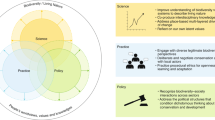Abstract
In their book, Defending Biodiversity, Newman, Varner, and Linquist (NVL) cast doubt on whether Leopoldian defenses of biodiversity, in their current form, have been successful. I argue that there is a more accurate interpretation of Leopold that is not subject to the criticisms made by NVL, and that Leopold’s body of work as a whole, including but not limited to the essay “The Land Ethic” in A Sand County Almanac, provides quite a bit of useful guidance and perspective. I begin with a brief summary of some of my own recent work on Leopold. This is intended to orient the reader who is more familiar with J. Baird Callicott’s influential interpretations of Leopold. I then discuss NVL’s Chapter 10 first followed by a discussion of their Chapter 9, responding to their critiques. I then conclude. On the revised interpretation that I have given, Leopold’s land ethic is defended by the method of reflective equilibrium, showing us that the land communities that we are interdependent with have intrinsic value, necessitating preserving their (land) health, which in turn necessitates preserving biodiversity.
Similar content being viewed by others
Notes
See Meine (2010).
That being said, I do not find group selection as problematic as NVL seem to; my point is only that it is not relevant for understanding or defending Leopold.
Again, it’s worth noting that Callicott’s more recent work attempts to address the larger scale with a defense of a Leopoldian “earth ethic” (Callicott 2013).
In what follows, “intrinsic value” can be understood in a minimal way, e.g., “things valued for their own sake apart from their usefulness to us” or in a more robust way, e.g. “things that have value even in the absence of any valuers.” NVL make a similar distinction in their book; my claim here is only that the arguments I make do not depend on one reading vs. another. As for Leopold, it’s clear that he at least means to endorse the minimal sense; whether his reference to “value in the philosophical sense” (1949, 223) commits him to the more robust sense is difficult to determine.
Although I think Leopold’s argument can reasonably be understood as deploying the method of reflective equilibrium, as explained below, not much hangs on that claim. If the reader prefers, it can simply be understood as an appeal to consistency in our ethical beliefs.
I hope that even without the textual evidence, this argument seems familiar to readers of “The Land Ethic.”.
See the essay “Thinking Like a Mountain” in ASCA.
References
Callicott JB (1987) The conceptual foundations of the land ethic. In: Callicott JB (ed) Companion to A Sand County Almanac. University of Wisconsin Press, Madison, pp 186–217
Callicott JB (2013) Thinking like a planet: the land ethic and the earth ethic. Oxford University Press, Oxford
Freyfogle ET (2008) Land ethic. In: Callicott JB, Frodeman R (eds) Encyclopedia of environmental ethics and philosophy. Macmillan Reference, New York
Leopold A (1949) A sand county almanac and sketches here and there. Oxford University Press, New York
Leopold A ([1942] 1999) Biotic land use. In Callicott JB, Freyfogle ET (eds) Aldo Leopold: for the health of the land: previously unpublished essays and other writings. Island Press, Washington, pp 198–207
Longino H (1990) Science as social knowledge. Princeton University Press, Princeton
Marietta DE Jr (1999) Environmental holism and individuals. In: Jardins JD (ed) Environmental ethics: concepts, policies, theories. Mountain View, Mayfield, pp 238–246
Meine C (2010) Aldo Leopold: his life and work. University of Wisconsin Press, Madison
Millstein RL (2015) Re-examining the Darwinian basis for Aldo Leopold’s land ethic. Ethics Policy Environ 18:301–317
Millstein RL (2018a) Understanding Leopold’s concept of ‘interdependence’ for environmental ethics and conservation biology. Philos Sci 85:1127–1139
Millstein RL (2018b) Debunking myths about Aldo Leopold’s land ethic. Biol Cons 217:391–396
Millstein RL (2018c) Is Aldo Leopold’s ‘land community’ an individual? In: Bueno O, Chen R, Fagan MB (eds) Individuation, process, and scientific practices. Oxford University Press, Oxford, pp 279–302
Newman JA, Varner G, Linquist S (2017) Defending biodiversity: environmental science and ethics. Cambridge University Press, Cambridge
Taylor P (1981) The ethics of respect for nature. Environmental Ethics 3:197–218
Warren JL (2016) Aldo Leopold’s Odyssey: rediscovering the author of A Sand County Almanac. 10th anniversary edition. Island Press
Author information
Authors and Affiliations
Corresponding author
Additional information
Publisher's Note
Springer Nature remains neutral with regard to jurisdictional claims in published maps and institutional affiliations.
An author’s reply to this comment is available at https://doi.org/10.1007/s10539-019-9725-8.
Rights and permissions
About this article
Cite this article
Millstein, R.L. Defending a Leopoldian basis for biodiversity: a response to Newman, Varner, and Linquist. Biol Philos 35, 12 (2020). https://doi.org/10.1007/s10539-019-9724-9
Received:
Accepted:
Published:
DOI: https://doi.org/10.1007/s10539-019-9724-9




